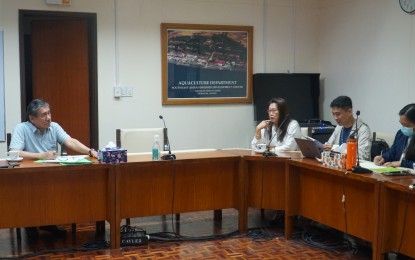
FEED MILL. Southeast Asian Fisheries Development Center - Aquaculture Department (SEAFDEC/AQD) chief Dan Baliao (left) meets with Bureau of Fisheries and Aquatic Resources 6 (Western Visayas) Director Remia Aparri (2nd from left) on Jan. 10, 2023 to discuss the development of commercial-scale aquaculture feed mills for cost-effective feeds. Baliao on Thursday (Jan. 19, 2023) said establishing a feed mill plant for cost-efficient feeds would invigorate the fisheries sector and help the country ensure food security. (Photo courtesy of SEAFDEC/AQD)
ILOILO CITY – The Bureau of Fisheries and Aquatic Resources (BFAR) has tapped the expertise of the Southeast Asian Fisheries Development Center - Aquaculture Department (SEAFDEC/AQD) to develop a PHP30 million commercial-scale aquaculture feed mill in Western Visayas for cost-effective feed.
The project under the National Fisheries Program will construct aquaculture feed mills in strategic locations in the country but will be piloted in Calabarzon and Mimaropa.
In Western Visayas, particularly in Panay Island, the feed mill is eyed at the main station of the SEAFDEC in Tigbauan, Iloilo with a fund support of PHP30 million and a counterpart fund of PHP250,000 from the center.
“Establishing a feed mill plant for cost-efficient feeds will likely invigorate the fisheries sector and help the country ensure food security by producing high-quality feeds at a reasonable price. This is also one way of increasing and sustaining aquaculture production of finfishes and cages in the area,” SEAFDEC/AQD chief Dan Baliao said in a press statement on Thursday.
Baliao said 60 percent of the production cost goes to feeds, thus deterring aquaculture production.
“We have to come up with a formulation that will cost less but efficient. We have formulated the feeds that cost lower than the commercial feeds,” he said. (PNA)
